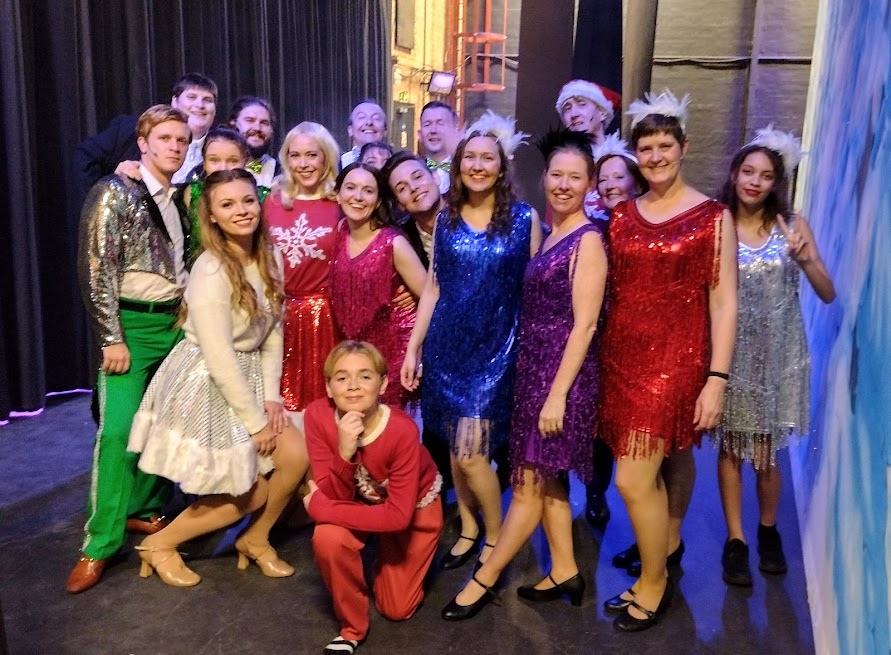Why is the cost of theatre tickets so high?
This is a different kind of post from my usual, but it still involves numbers, and in a real-life context too: that of budgeting a musical theatre show and deciding how to set the cost of theatre tickets.
As well as being a Maths tutor, I’m Treasurer for a local musical theatre society (STAMPS). We’ve just had our annual main show week – this year’s show (November 2022) was “Elf the Musical” and you can read a review here if you’re interested – and of course it falls to me to deal with the finances.
It may surprise you to hear that it typically costs an amateur theatre society somewhere in the region of £30,000 to put on a musical – it certainly surprised me when I first took on this role!
Disclaimer: The content of this article is based only on my own fairly limited experience, but I hope it’s fairly representative of what other societies have to deal with too!
The run-up to the show
During the months leading up to the performance, we rehearse in a local hall or function room, using chairs and tables for scenery. Generally we have a full-company rehearsal one evening a week and principal rehearsals (principals are the main characters) on another evening, but during the final month of the run-up we step up to three rehearsals a week with the full cast present.

We have a Musical Director who works with us throughout rehearsals and provides the music using a keyboard, but for the actual show we bring in a live band, conducted by the MD and composed of professional musicians.
If we’re lucky we’ll get the hired costumes a couple of weeks in advance, giving time for any necessary alterations to be made and missing items to be sourced, but sometimes we don’t get them until we arrive at the theatre.
In our case the actual show takes place at the local council-run theatre, which seats a maximum of 336 audience members, and we’re one of about eight local amateur companies that each put on an annual musical there. The usual schedule goes like this:
Sunday: get-in day
Arrive at 9am and…
- Help the stage crew to unload the hired scenery from the delivery lorry (at our theatre it’s delivered on the roof and unloaded into a lift the size of a shipping container!).
- Help to set it all up and hang the cloths (gauzes and opaque backdrops), and decide what can and can’t be used in the space we have available.
- Attend Band Call, which is the first time the band gets together and plays through the music for the show. I’m always in awe of how professional musicians can play so well at sight!
- Run through any scenes that we expect to need tweaking, or that present potential safety hazards – for example scenes that involve flying or, in our case this year, skating, or where the actual space and scenery don’t match what we’d rehearsed.
- Run a full technical rehearsal; this is mainly for the benefit of the stage crew. allowing them to map out what scenery needs to be where at what time, but also allows the cast to establish timings for costume changes and find somewhere to stash their props.
- Finish and go home sometime around 10-11 pm.
Monday: dress rehearsal
Arrive around 6pm, and get ready for curtain-up at 7.30. This means getting into costume and make-up, and preparing any props required, and may involve putting costumes downstairs in the scenery dock if a quick change is needed and there isn’t time to go up to the dressing room (our dressing rooms are arranged over three floors). Anyone using a radio mic also needs to do a sound check on stage. We try to have a vocal and physical warm-up before the show begins, though sometimes things are so hectic backstage that that doesn’t happen.
A typical musical has Act 1 a little over an hour long and Act 2 a little under, with a 20-minute interval. Most of us get a break during the interval, but the stage crew can be very busy reorganising the scenery to give easy access to the pieces they’re going to need for Act 2.
Tuesday to Saturday: live performances
We normally do five evening performances and a Saturday matinee. Weekday matinees aren’t an option since many of the cast and crew are at work / college / school during the day. On each occasion we arrive at least an hour before curtain-up and get ready – the same process as described for the dress rehearsal, but of course we get slicker at it as the week progresses.
After the final performance we have to break down the set and reload it for return to the set hire company, return the costumes to the costume hire company (who will normally come to collect them) and completely clear all our belongings out of the theatre, so it’s a late finish.

Who gets paid?
In an amateur show, the Producer/Director, Choreographer and Musical Director each get paid a pre-agreed flat fee – but although it’s significant from the point of view of budgeting the show, if it were broken down into an hourly wage for the amount of time they put in, they’d all be getting well below minimum wage. This isn’t something that anyone does for the money!
None of the performers are paid; on the contrary, they actually pay a membership subscription to cover ongoing costs such as insurance and rehearsal hall hire.
The stage crew are all volunteers too – some people perform with one company and help out as stage crew for others. The only payment they get is a round of drinks paid for by the company whose show it is, and whatever treats the cast may supply during show week.
The professional musicians who perform in the band are paid, typically for eight performances: Band Call, the dress rehearsal and six live performances. The pay isn’t very high considering their incredible level of skill, but when you have up to 11 musicians in the band (which at our theatre makes for a very crowded orchestra pit!) the overall cost is substantial nevertheless.
If there are children – up to the end of Year 11 – in the show then child employment laws apply, even though the children aren’t actually employed: each child needs a licence issued by the local authority that they live in, and a qualified chaperone has to be provided. There’s no charge for the licence, and as far as possible we’ll use volunteer chaperones who are the parents of children involved in our and other local theatre companies, but sometimes we have to pay a professional to come in.
Of course, if it were a professional show then the cast and crew would be paid, as would all the chaperones, and the MD, Director and Choregrapher would receive more substantial fees.
So what are the costs?
The cost of room hire for rehearsals is typically around £35-£50 per rehearsal. At two rehearsals per week for six months that comes to around £2000-£2500. Then there are expenses such as insurance, memberships and website hosting. These costs are normally covered by membership subs so I’m not including them in the show costs.
However, we need to set the cost of theatre tickets with a view to covering all of the following expenses:
Production management fees (for the MD, Director and Choreographer) typically come to around £4000 but can be higher.
We have to pay royalties to the rights holder for the privilege of performing the show; this typically costs around 15-16% of ticket sales… plus VAT, so in reality it’s about 18-19%. So if we sell a total of 1500 tickets at £20 each – that’s roughly 75% of the maximum possible at our local theatre – then that works out at £4500 at 15%, and £5400 once you’ve added on the VAT. In addition, the hire of rehearsal materials (scripts/songbooks for the cast and rehearsal score for the MD), and band parts for the orchestra, exceeds £1000.
Theatre hire is a little short of £5000 for the week, but there are additional costs for the use of the PA system and radio mics, and those aren’t cheap – we’re talking another £2500-3000!
If you want special effects such as people or scenery flying on stage then that costs extra too; for this show we had to abandon the idea of having Santa’s sleigh take flight as it would have cost us an additional £800.
Set hire is into the thousands of pounds and carriage costs are high too – you’re paying for an entire lorryload to be delivered at 9am on a Sunday and picked up again the following Saturday night. There’s also less competition than there used to be, because Covid drove some set hire companies out of business. Our set for this year’s show was particularly expensive since it was the only one available in the UK – and it was designed for a significantly bigger stage than ours so we couldn’t even use a lot of the pieces supplied. Let’s say that typical set hire costs around £3500.
(Of course, there’s the option of building your own set, which in some cases might work out cheaper – but you’d need a significant amount of storage space for it, which most amateur companies just don’t have. Besides, you’d still need to hire in the cloths, and even if the scenery hire company were happy to provide only that element of the scenery, it would still involve subtantial expense. Some shows use a projected backdrop for many scenes, but the cost of a sufficently powerful projector for the size of screen needed is prohibitive for most.)
Then there’s costume hire – around £25 per costume, often with multiple costumes per cast member and up to 40 people in the cast – so that’s typically around £2000-£4000. And there will likely be several hundred pounds’ worth of props too. Ours included eight large Santa sacks, space hoppers to put in them (mostly begged or borrowed but we did need to buy a couple), a narwhal hat, a New York skyline snowglobe and copious amounts of tinsel.
For the band it’s around £3500 to £5000 depending on how many musicians are needed.
We also need to print publicity materials and programmes; we hope to make a small profit on the programmes, with paid adverts and volunteers selling them on Front of House, but the total investment here is around £1000.
What does it take to break even?
Totting up typical costs from those above, we have:
- Production management costs £4000
- Royalties £5400 (based on 75% ticket sales at £20 and a royalty rate of 15% + VAT; for 60% sales at £18 it would be £3888)
- Hire of rehearsal materials and band parts £1100
- Venue hire, PA system and radio mics £7500
- Set hire £3500
- Costumes and props £3000
- Musicians £4200
- Publicity and programmes £1000
… giving a total outlay of £29,700.
We also pay a 2.5% card commission on any card sales that the Box Office makes. That’s 50p on a £20 ticket so, depending on how many sales are made through the Box Office and paid for by card, it’s typically about £600-£800. We have a volunteer ticket secretary who manages sales made through cast members, which helps with cashflow (this year the set and costumes had to be paid for in full before show week, as well as various deposits) and avoids the Box Office commission on those sales, but the majority of sales are made through the Box Office.
And the ticket sales from our six performances (plus programme sales) need to cover all those expenses. Unlike a film company, we can’t distribute copies of our performance for multiple showings on screens all over the world. We have to pay an extra fee to the rights holder even just to be allowed to make a single recording for archive purposes.
As I mentioned earlier, our local theatre seats a maximum of 336. Ignoring the card commission on Box Office sales, if 75% of the seats are sold across the whole run, and the cost of theatre tickets is £20 per seat, then that’s a total income from tickets of £30,240, which covers our £29,700 in costs with a little to spare. If we only sell 60% then it’s £24,162 – well short of covering our costs (which would be around £28,000 due to a reduction in the royalties due). At £18 per seat we’d have to sell around 80% of the seats to break even.
Schools can put a show on much more cheaply, of course. They don’t have to hire a venue and they’ll normally use their own in-house musicians or a recorded soundtrack and, for the most part, will be able to build their own sets (which they can store and reuse afterwards) and make their own costumes. They also get charged much lower licence fees by the rights holder.
On the other hand, a professional show is much more expensive to put on, mainly because everyone involved has to be paid a wage, though of course professional shows tend to go to town more on the special effects too. So the cost of theatre tickets for a professional show is considerably higher in most cases.
So there you go – now you know why the cost of theatre tickets is so much more than that of cinema tickets.
And don’t forget, by coming to see a live theatre show you’re getting to see a unique performance that will never be repeated. You don’t get that at the cinema!
Would you like to see more posts related to real-life finances? If you would, or if you have any other requests, then please comment below or let me know using my contact form!

